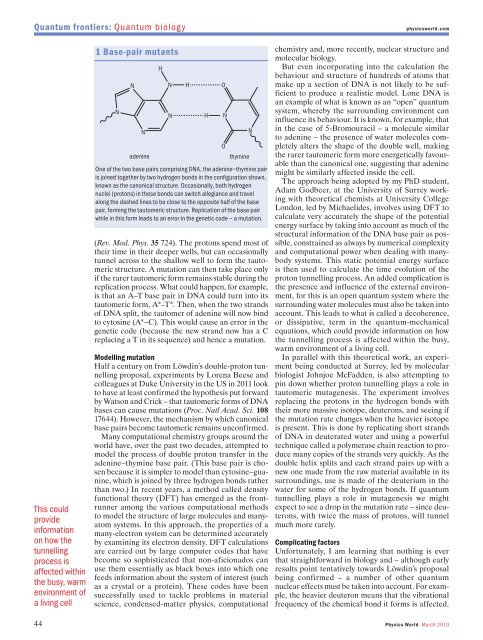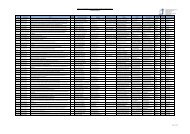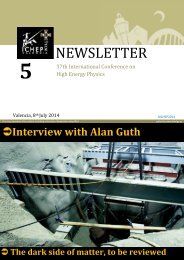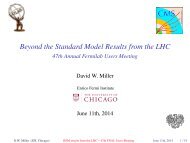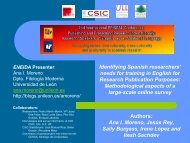PW_mar13_sample_issue
PW_mar13_sample_issue
PW_mar13_sample_issue
You also want an ePaper? Increase the reach of your titles
YUMPU automatically turns print PDFs into web optimized ePapers that Google loves.
Quantum frontiers: Quantum biology<br />
This could<br />
provide<br />
information<br />
on how the<br />
tunnelling<br />
process is<br />
affected within<br />
the busy, warm<br />
environment of<br />
a living cell<br />
44<br />
1 Base-pair mutants<br />
N<br />
N<br />
N<br />
H<br />
N<br />
N<br />
H O<br />
O<br />
adenine thymine<br />
One of the two base pairs comprising DNA, the adenine–thymine pair<br />
is joined together by two hydrogen bonds in the configuration shown,<br />
known as the canonical structure. Occasionally, both hydrogen<br />
nuclei (protons) in these bonds can switch allegiance and travel<br />
along the dashed lines to be close to the opposite half of the base<br />
pair, forming the tautomeric structure. Replication of the base pair<br />
while in this form leads to an error in the genetic code – a mutation.<br />
(Rev. Mod. Phys. 35 724). The protons spend most of<br />
their time in their deeper wells, but can occasionally<br />
tunnel across to the shallow well to form the tautomeric<br />
structure. A mutation can then take place only<br />
if the rarer tautomeric form remains stable during the<br />
replication process. What could happen, for example,<br />
is that an A–T base pair in DNA could turn into its<br />
tautomeric form, A*–T*. Then, when the two strands<br />
of DNA split, the tautomer of adenine will now bind<br />
to cytosine (A*–C). This would cause an error in the<br />
genetic code (because the new strand now has a C<br />
replacing a T in its sequence) and hence a mutation.<br />
Modelling mutation<br />
Half a century on from Löwdin’s double-proton tunnelling<br />
proposal, experiments by Lorena Beese and<br />
colleagues at Duke University in the US in 2011 look<br />
to have at least confirmed the hypothesis put forward<br />
by Watson and Crick – that tautomeric forms of DNA<br />
bases can cause mutations (Proc. Natl Acad. Sci. 108<br />
17644). However, the mechanism by which canonical<br />
base pairs become tautomeric remains unconfirmed.<br />
Many computational chemistry groups around the<br />
world have, over the past two decades, attempted to<br />
model the process of double proton transfer in the<br />
adenine–thymine base pair. (This base pair is chosen<br />
because it is simpler to model than cytosine–guanine,<br />
which is joined by three hydrogen bonds rather<br />
than two.) In recent years, a method called density<br />
functional theory (DFT) has emerged as the frontrunner<br />
among the various computational methods<br />
to model the structure of large molecules and manyatom<br />
systems. In this approach, the properties of a<br />
many-electron system can be determined accurately<br />
by examining its electron density. DFT calculations<br />
are carried out by large computer codes that have<br />
become so sophisticated that non-aficionados can<br />
use them essentially as black boxes into which one<br />
feeds information about the system of interest (such<br />
as a crystal or a protein). These codes have been<br />
successfully used to tackle problems in material<br />
science, condensed-matter physics, computational<br />
H<br />
N<br />
N<br />
physicsworld.com<br />
chemistry and, more recently, nuclear structure and<br />
molecular biology.<br />
But even incorporating into the calculation the<br />
behaviour and structure of hundreds of atoms that<br />
make up a section of DNA is not likely to be sufficient<br />
to produce a realistic model. Lone DNA is<br />
an example of what is known as an “open” quantum<br />
system, whereby the surrounding environment can<br />
influence its behaviour. It is known, for example, that<br />
in the case of 5-Bromouracil – a molecule similar<br />
to adenine – the presence of water molecules completely<br />
alters the shape of the double well, making<br />
the rarer tautomeric form more energetically favourable<br />
than the canonical one, suggesting that adenine<br />
might be similarly affected inside the cell.<br />
The approach being adopted by my PhD student,<br />
Adam Godbeer, at the University of Surrey working<br />
with theoretical chemists at University College<br />
London, led by Michaelides, involves using DFT to<br />
calculate very accurately the shape of the potential<br />
energy surface by taking into account as much of the<br />
structural information of the DNA base pair as possible,<br />
constrained as always by numerical complexity<br />
and computational power when dealing with manybody<br />
systems. This static potential energy surface<br />
is then used to calculate the time evolution of the<br />
proton tunnelling process. An added complication is<br />
the presence and influence of the external environment,<br />
for this is an open quantum system where the<br />
surrounding water molecules must also be taken into<br />
account. This leads to what is called a decoherence,<br />
or dissipative, term in the quantum-mechanical<br />
equations, which could provide information on how<br />
the tunnelling process is affected within the busy,<br />
warm environment of a living cell.<br />
In parallel with this theoretical work, an experiment<br />
being conducted at Surrey, led by molecular<br />
biologist Johnjoe McFadden, is also attempting to<br />
pin down whether proton tunnelling plays a role in<br />
tautomeric mutagenesis. The experiment involves<br />
replacing the protons in the hydrogen bonds with<br />
their more massive isotope, deuterons, and seeing if<br />
the mutation rate changes when the heavier isotope<br />
is present. This is done by replicating short strands<br />
of DNA in deuterated water and using a powerful<br />
technique called a polymerase chain reaction to produce<br />
many copies of the strands very quickly. As the<br />
double helix splits and each strand pairs up with a<br />
new one made from the raw material available in its<br />
surroundings, use is made of the deuterium in the<br />
water for some of the hydrogen bonds. If quantum<br />
tunnelling plays a role in mutagenesis we might<br />
expect to see a drop in the mutation rate – since deuterons,<br />
with twice the mass of protons, will tunnel<br />
much more rarely.<br />
Complicating factors<br />
Unfortunately, I am learning that nothing is ever<br />
that straightforward in biology and – although early<br />
results point tentatively towards Löwdin’s proposal<br />
being confirmed – a number of other quantum<br />
nuclear effects must be taken into account. For example,<br />
the heavier deuteron means that the vibrational<br />
frequency of the chemical bond it forms is affected.<br />
Physics World March 2013


